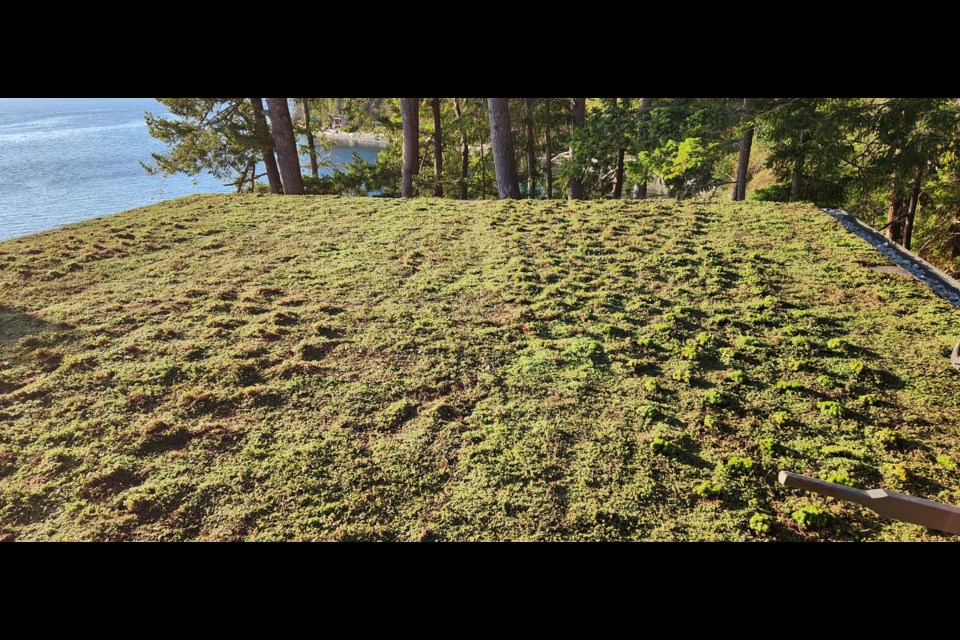Municipalities, cities and individuals have many reasons for deciding to go green on the roofs of their businesses, community spaces or homes. One is climate change mitigation, another is energy savings.
Also called living architecture, or living roofs, they can create a space that is cooling, insulated and alive, instead of a heat sink with only one purpose: to provide a roof over one's head.
Horticulturist Darren Burns and his crew at Paradise Valley Landscaping have been creating beautiful outdoor designs for folks in the qathet region for more than 20 years, but recently took on a new challenge, installing a green roof.
"They [green roofs] have been in Europe for years and this company called ZinCo from Germany recently brought it [the technology] to Canada," said Burns.
Some lesser-known benefits to greening the roof of a building is its ability to reduce stormwater run-off, improve air quality and create habitat for birds and pollinators.
"The roof that went over the garage and parts of the lower level is flat with very minimal slope," said Burns. "It was just black asphalt, so we put a green roof primarily with sedums, which are succulents and drought tolerant, and we also installed some different perennials."
The trend now for many gardeners in coastal communities of BC is to plant native and drought-tolerant plants to avoid the need to use a lot of water. The green roof installed south of town doesn't need an irrigation system, said Burns, although a little watering now and then won't hurt.
"Aesthetically, [the green roof] looks good, but one of the big reasons people want that kind of roof is it captures water from run-off," he added.
Burns said, for example, in Hamburg, Germany, 70 per cent of roofs are considered green.
"When you get a big rainstorm, because the water filters through it, there is not a big gush of water that causes storm sewers to overflow and cause civil damage," he added. "It's a multilayered system and as long as you have a not-too-steep roof, with a bit of a slope, to a fully flat roof, a green roof could work."
The installation took about a week for the crew to put in a waterproof membrane, floor drain and a protection layer.
"This type of technology provides cooling and heating for the home, a type of insulation," said Burns.
Some green roofs include plants to absorb pollutants, filter the water and grow food.
Many cities, such as Vancouver, have implemented a climate strategy by installing green rainwater infrastructure and encouraging new buildings to have a living roof, in order to mitigate the warming climate and the city from becoming a heat sink.
"I'm a horticulturist and I have been working in this field for decades, but you look at the climate change we're encountering now, the longer drought periods, and so we have started with a method called xeriscaping," said Burns. "Which means putting plants in that can live in this environment with low water requirements."
Over the years Burns said he and his crew have changed how and what they plant.
"Mulches and drought-tolerant plants, native plants, ornamental grasses, they will fare better through our hot seasons, and they're still very attractive, but you're getting away from the ones that require more moisture," said Burns. "I'm a gardener so I see the ground as a place to grow something, whether or not it's edible, it's a nicer place to be."
Many folks in southern and coastal BC communities have been slowly switching from grass lawns to more of a living landscape.
Older trees should be valued, said Burns, as they provide a lot of benefit not just to the natural ecosystem but to humans as well, because they provide very good shade and cooling as well as habitat for birds and other animals.
Replacing asphalt with plants and grasses can turn an area that was once an uncomfortable heat sink into a welcoming place for both humans and wildlife.
Contact Darren Burns at Paradise Valley Landscaping by calling 604.414.8427
Join the Peak’s email list for the top headlines right in your inbox Monday to Friday.




